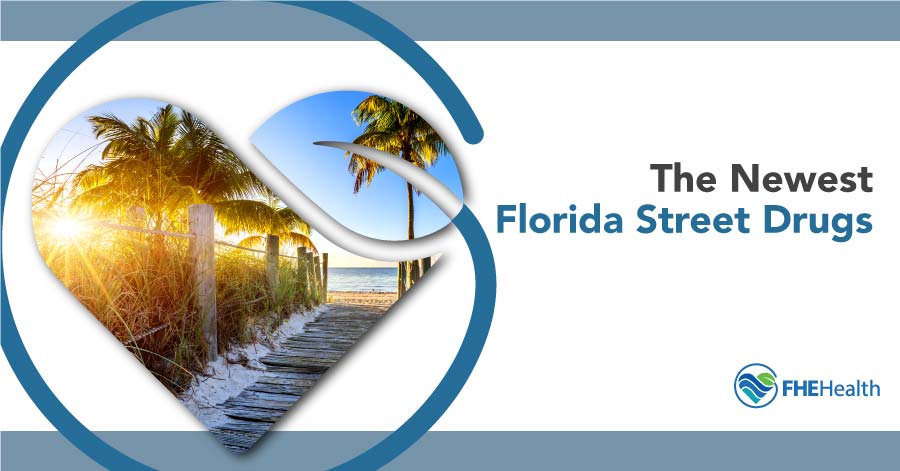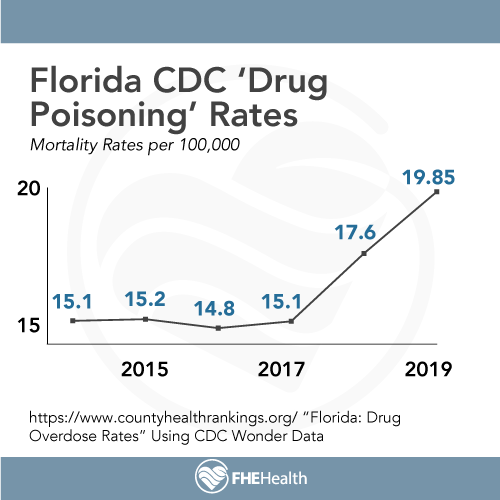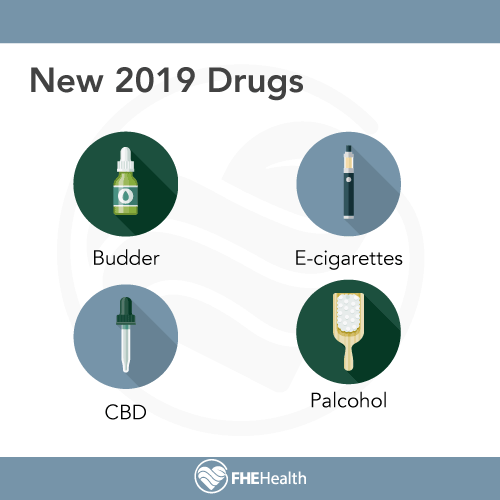
A look back on 2019 drug trends in Florida reveals patterns of substance use across the state as well as some new drugs emerging on the scene. Although there continue to be statewide declines in cigarette smoking and alcohol abuse, vaping rates have risen and new designer drugs have emerged.
2019 Overview
Florida remains an epicenter of drug use. Because Florida provides a convenient point of entry for drug cartels, drugs of all types continue to be heavy in concentration across the state and in both urban and rural areas. Opioids continue to ravage the state, even as new drugs are regularly emerging.
Have drug overdoses remained steady, risen or fallen?
In spite of two laws being passed in the last decade to combat illegal prescription drug use, drug overdose rates continue to rise. The Florida legislature passed a new law that requires the tracing of drug overdose data, allowing Florida to accurately track and monitor the drug crisis.
Any additional overview of 2019/trending news
The continuing uptick in the rate of meth lab seizures has persisted through this year. However, it does not appear to have affected rates of drug use or overdose. One reason for this is the new method of meth production referred to as “one pot.” Simply stated, “one-pot” refers to the use of mobile meth labs which can pop up with little planning or equipment. Additionally, the use of crystal meth, prominent in the Florida club scene, continues to rise.
Known Drugs On The Scene
 Flakka
Flakka
Remember the bizarre stories about people using baths salts to get high in Miami? Flakka was and remains one of the top new drugs in Miami. It is a derivative of bath salt substances. It looks like small white or pink rocks and is often colloquially referred to as gravel, based on this appearance. The main danger of flakka is how it’s created. Flakka can be “cut” with substances ranging from muscle relaxers to rat poison. We simply don’t know what’s in every batch of flakka found in Florida.
Flakka is an extremely addictive stimulant that has become especially popular in South Florida, Tennessee, and southwestern Virginia. The good news is that recent reports reveal that flakka is not commonly used by high school-aged individuals. The drug can be smoked, injected, or snorted and it leads to severe hallucinations and paranoia. The prolonged use of flakka has been linked to kidney failure. Drug makers continue to tweak the ingredients in order to continue making flakka.
Kratom
Thailand is home to a certain tree with leaves that can be chewed or eaten for the purpose of getting high. While illegal in Thailand, many people in that country—and now others—have continually used kratom as a means of catching a buzz. More and more countries are taking a look at this psychoactive leaf that, depending on the dosage, can act as either a stimulant or depressant. Kratom is commonly found in teas, powders, or in capsule form.
A recent FDA kratom testing revealed that the substance has high levels of heavy metals that exceed healthy levels and can result in metal poisoning. Kratom is now being used in herbal supplements sold in stores, which minimizes the perception of the potentially very harmful effects of the drug.
Spice
Spice is one of the common Florida drugs found in convenience stores, online, and smoke shops all over— and with loopholes, can be sold legally. It might be marked as “legal and natural,” sold in packages with labels of “not for consumption” and marketed as incense to ward off any law enforcement or legal issues. But many people, especially teens, are smoking Spice to get high. Its active ingredient is actually just a tweaked type of synthetic cannabinoid. Many chemicals found in Spice are classified as illegal substances by the DEA, (so it may go without saying that Spice manufacturers bypass these legal restrictions). Other common names associated with Spice are “Moon Rocks,” “Fake Pot,” “Scooby Snax,” “Black Mamba,” and “K2.” Spice blends are especially dangerous because we simply don’t know all the ingredients that are present in these blends.
Vitamin K/Special K
The “K” in these names comes from ketamine, a drug that was originally made over 60 years ago as a type of veterinary anesthetic. That’s right, a drug to put animals to sleep. By the 1970s, ketamine made its way into the black market. There, it eventually became “angel dust” or PCP. Today, ketamine is popular at night clubs and raves. It can be injected, poured into drinks as a liquid, converted into a powder, smoked, or snorted. In the liquid form especially, ketamine is known as one of several “date rape drugs.” Ketamine does have growing, legitimate medical use for treating depression in a controlled environment.
Smiles
Smiles is a new type of drug found on Florida streets that is similar to a street drug called “N-bomb.” Both of the drugs are derived from a psychedelic drug dating back to 2003 called “25I-NBOMe.” The only difference in N-bomb and smiles is the substitution of one iodine atom for a chlorine atom. The technical name for this is “2C-1.” It is a synthetic drug like bath salts, K2 or Spice. It is both a hallucinogen and an amphetamine. Typically, hallucinogens do not have dangerous overdose potential; however, when combined with an amphetamine, they can lead to methamphetamine-like overdoses and be just as life-threatening. Smiles comes in pill, liquid, or powder form and can lead to hallucinations, seizures, and panic attacks. It is a Schedule I drug due to its dangerous nature and absence of use in the medical field. The drug is extremely difficult to trace in testing. By mid-2013, at least five deaths nationwide were attributed to the use of smiles. Oh, and the name of the drug, smiles, stems from the abbreviation for: “Simplified molecular-input line-entry system.”
Molly
Molly has become increasingly popular throughout the state of Florida over the last few years. It’s a refined version of Ecstasy or MDMA and many users think Molly is the safer version— even though that isn’t necessarily the case. Molly can lead to confusion, difficulties in regulating body temperature, and issues with heart rate and breathing control. In 2013 at a music festival in Washington, one person died and 15 were hospitalized in intensive care after taking Molly. It’s of low cost and therefore popular in college towns. Recent studies show a potential for long-term brain damage with prolonged use of Molly. Learn more about the purity of ecstasy across the nation in our study, Festie Besties.
Acetyl Fentanyl
This is a new synthetic type of opioid that is frighteningly five times more potent than heroin. Because of its extreme potency, it was never marketed for any sort of medical use. In 2013, law enforcement started seeing the drug spring up in overdose cases, where it was associated with 14 overdose deaths in Rhode Island alone. Dozens of more overdoses have been reported in Pennsylvania, North Carolina, and Louisiana. The issue is so serious that the CDC requires emergency rooms to have naloxone (an antidote to the drug and other opioid overdoses) on hand at all times.
Fentanyl overdoses continued to climb throughout Southwest Florida in 2019. In one instance, over 100 people were arrested in a massive Florida drug bust where enough fentanyl was seized to wipe out a small country.
New Drugs in Florida as of 2019
 Budder
Budder
Also known as “shatter” and “honey oil,” “budder” is a highly potent substance extracted from cannabis. It contains highly toxic and dangerous levels of delta-9-tetrahydrocannabinol (THC), which is the primary psychoactive ingredient in the cannabis plant. Manufacturers of budder soak the cannabis in butane or another solvent. The substance is then vaped. The high THC level can lead to harmful side effects, including heart palpitations, paranoia, and severe anxiety. Budder is now one of the most popular drugs of abuse in Florida.
CBD in Florida
Recent changes in law legalizing hemp and its derivatives and allowing the use of medical cannabis has resulted in an increase of illegal CBD use. Although products that contain less than .3% of THC are legal, an emergence of products advertised and promoted as CBD actually contains high amounts of THC.
E-cigarettes
While the Florida government has worked to ban public vaping to prevent second-hand inhalation, new substances are emerging designed to be used in common e-cigarettes. Candy-flavored vape juice with high levels of nicotine or THC substance are commonly used by Florida teens and pre-teens.
Palcohol
Although we typically think of alcohol as a liquid, powered alcohol is an actual thing. It is essentially a packet of alcohol in powder form that can be mixed with water to create a cocktail. Florida teens are commonly snorting palcohol and mixing it with food. The result is a dangerous and fast acting high.
We’re aware of drugs like marijuana, heroin, cocaine, and meth— those names (unfortunately) make their mark in Florida news stories each day, only enhancing their familiarity. On top of that, chances are, you or someone who you know in Florida has used or misused these common drugs.
How to Stay Updated on New Drug Dangers in Florida
But what about the next generation of drugs being consumed in the Sunshine State? The ones that we don’t even know about? What about the drugs that backyard and basement “chemists” are concocting by slightly tweaking formulas and bypassing legal loopholes?
For an updated blog on recent drug trends, read more. For information regarding the location and times of public forums on the newest street drugs in Florida, you can also call (833) 596-3502.






